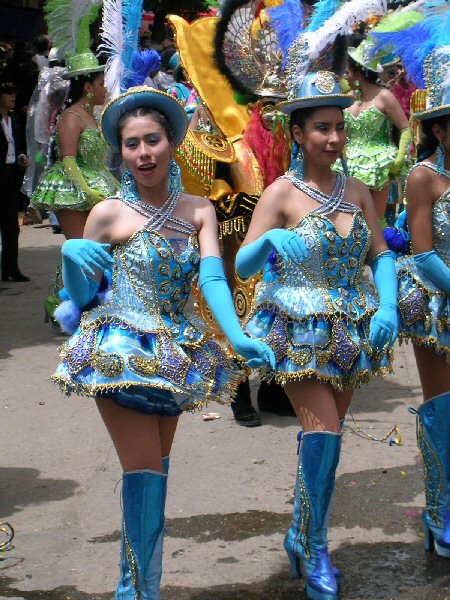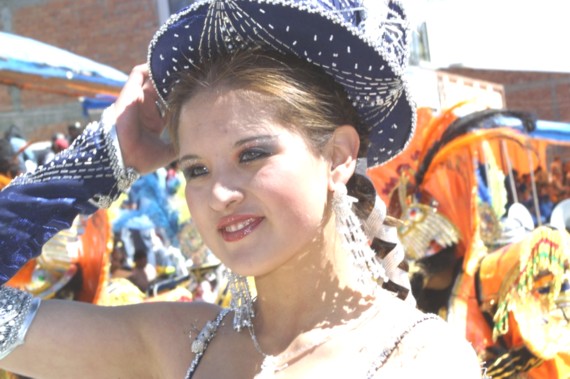
The department of Oruro is the capital of the country folk, known for its magnificent and lavish Carnaval declared «Masterpiece of Oral and Intangible Heritage of Humanity.» Behind this devotional feast, Oruro lies a wealth of natural resources and ancestral culture.
The city of Oruro to this (m.s.n.m. 3.706).
One cannot fail to mention the unique natural features that it has this department, surrounded by volcanoes, salt flats and flamingos. Moreover, the great Lake Bird Sanctuary and Poopó Sajama National Park, considered the world’s highest forest, form a harmonious whole of natural beauty.

Climate:
The department of Oruro is cold and dry climate with an average temperature of 9 degrees Celsius.
Polar cold weather in the high peaks of the Cordillera Occidental; cold dry puna brava (plateaus above 4000 m), cold in the highlands with a tendency to warm in spring and summer.
Attractions:
Lake Poopo
Located 65 kilometers from Oruro, in the path that leads to the neighboring department of Potosí.
In the Lake Poopó, apart from knowing it, are also attractive Sanctuary Quillacas settlements and burial, Sora-Sora, Poopó, Pazner, Challapata and Machacamarca sites which offer interesting visits to their churches, baths springs, and Uru Uru Lake where you will enjoy scenery of incomparable beauty.
Sajama National Park
In the National Park forest lies queñua and Sajama volcano, at an altitude of 6542 meters, becoming the country’s highest peak, is also considered holy in pre-Hispanic times. It takes around archaeological sites.

The River chullpas Lauca
In Lauca River area is an important set of Chullpas, pre-Columbian tombs. These are characterized by being decorated with geometric figures formed by adobes of different colors. On both sides of the river overlooking the ponds and Macaya Sabacaya arranged symmetrically with respect to Lauca like two big eyes in an anthropomorphic context.
Spa straining Obrajes
Its waters, hot medicinal, will be a temptation if you get to Oruro.
Straining, which is located 12 kilometers from the city, has indoor pools and individual Obrajes, 25 kilometers, is an important recreation center, where you will find comfortable accommodation.
Arenales de San Pedro
The impressive sand dunes, which seem drawn from a vast desert landscape gives a special at the foot of Cerro San Pedro, which is two kilometers from the city.
Cala Cala
At 20 kilometers from Oruro this archaeological site is located where there are cave paintings of pre-Columbian origin. Cattle herders, flamingos, llamas and cats, were outlined with simple strokes by former Bolivian.
Bridge Chullpares
From this bridge, built in colonial times, you can see the majesty of the highlands. In its vicinity is the necropolis of prehispanic Chusaqueri, in which there are funerary monuments of stone and mud.
Paria
A temple stone mixed style is the «jewel» of the first primary in the town founded by Spanish conquistadors. According to historical data, Paria was founded in 1535 by Diego de Almagro and Captain Juan de Saavedra.
The Church of Yarvicoya
It is another remarkable example of baroque art, located a few kilometers from Oruro, within the jurisdiction of Caracollo, Cercado Province, diverted to the east of the highway to La Paz. The church, a national monument, is a single nave with triumphal arch, ends, and full choir, and tower attached cover entirely carved in stone. Data from the XVI century, with signs of recent renovation and has an altarpiece painted with gold leaf, which mimic figures of serpents.
Cuisine:
In Oruro, there are dishes prepared from products of Bolivian origin, such as API, charquecán, and many made with lamb, such as toast, and peppered his face the roast, which is the most characteristic.
The API is a drink of purple or yellow, made of cornmeal, which has the peculiarity of not cooled quickly. The most common use for a glass of rich api is the market Fermin Lopez.
The charquecán contains several elements, such as potato, cheese, nickname, last egg, and most important is the fact jerky, meat called now. The manufacturing process is basically the jerky dehydration of the meat with salt, which is exposed to sun for several days. Then the water runs, it crumbles and Machuca, to bring the hot oil, it is important to accompany this dish with a rich llajua (locoto tomato sauce and a chili of the region).
The lamb is widely used by orureños for cooking because it is the basis of many dishes Oruro, eg face roast very characteristic of the place, which is found only in the evenings from 21:00 pm by October 6th Street. It consists of a lamb’s head, before they clean your teeth is then seasoned with salt, and puts it in the oven, and all wool.
It is also peppered the lamb, but is done with the part of the legs of the animal, making a few cuts, he introduced various pieces of vegetables, and season it with salt and pepper and put in oven.
The toasts are chunks of lamb fried in oil with salt, which, like the peppered can be served with rice, potatoes, Chun, salads, and others.
Leave a Reply
You must be logged in to post a comment.
Recent Comments